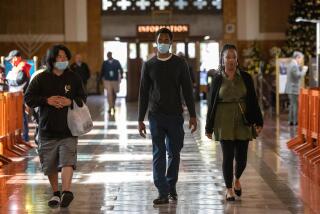Some Blood Cells Blocking AIDS, Scientists Discover
- Share via
AIDS researchers in San Francisco have discovered a mechanism that seems to explain why not everyone who is infected by the AIDS virus develops the deadly disease.
The finding may open a major new research avenue into ways to ward off acquired immune deficiency syndrome, scientists at the University of California, San Francisco, said in their report, published in today’s Science magazine.
“This is the first time that a natural immune response to the AIDS virus has been shown,” Jay Levy, one of the researchers, said in a telephone interview.
The finding emerged from studies involving three people who were healthy but were known to have been infected by the virus, as evidenced by the presence of antibodies in their blood.
The researchers took blood samples from them and removed certain white blood cells that normally might protect against viral infections. With these “suppressor” cells gone, the AIDS virus quickly became detectable in the blood that was left in the laboratory dish. But when the cells were returned to the blood in the dish, the AIDS virus once again was suppressed.
The suppressor cells are known as CD-8 cells. Levy suggested that it may be possible to prolong an individual’s protection by removing such cells, artificially bolstering them in the laboratory with an immune-enhancing substance like interleukin-2 and then returning them to the patient.
“This discovery could be the first step toward an effective therapy for AIDS, using a person’s own immune cells rather than drugs that are toxic to the body,” he said.
“I’m really excited by this. It fits into our belief that if your immune system is functioning well, you should be able to handle this virus.”
Levy said he believes that having an adequate number of healthy CD-8 cells is an important factor in keeping the dormant AIDS virus from replicating. He speculated that people who succumb to the virus may either lack a sufficient number of these cells or possess defective ones.
Although the mechanism by which CD-8 cells achieve their protective effect is unknown, Levy said he believes that they manufacture a natural chemical that suppresses, but does not kill, the AIDS virus.
In the early years of the AIDS epidemic, the federal Centers for Disease Control estimated that about 10% of infected Americans would develop AIDS. More recently, that estimate has risen to 20% to 30%. A few studies, involving smaller study populations, have put that figure even higher--up to 75%.
Permanency Unknown
It is unknown whether the body’s natural protection against the virus provided by CD-8 cells is a permanent one.
CD-8 cells are a subset of T-cells, one of the two major classes of white blood cells that are the immune system’s principal protective agents. T-cells secrete chemicals and provide help that is essential for the manufacture of antibodies.
Antibodies are produced by B-cells, the other arm of the immune system. B-cells produce antibodies when a foreign substance, including a virus, invades the body.
Levy’s notion of treating CD-8 cells outside the body with substances like the naturally occurring immune enhancer interleukin-2 also would overcome a condition seen in patients given IL-2 in treatments for other diseases.
When injected into the body, IL-2 results in a proliferation of T-4 cells, and these cells are a major target of the AIDS virus.
Levy said he and his colleagues, Christopher M. Walker and D. J. Moody, are looking for a person in the early stages of developing the symptoms of AIDS on whom to try the experimental CD-8 therapy.
Nervous System Trouble
In another AIDS development Thursday, researchers at a medical meeting in San Francisco provided new data that underscored the high frequency of nervous system disorders among AIDS patients.
Of 1,286 patients treated at UC San Francisco hospitals through September, 37% had such significant nervous system complaints as confusion, headaches and muscle weakness, according to Dr. Robert M. Levy, a neurosurgeon.
In 10% of the AIDS patients studied, a nervous system problem was the first sign of the disease.
Another UC San Francisco study suggested that by the time AIDS patients die, most will have developed brain diseases. In 100 consecutive autopsies, 75% had evidence of brain damage, Levy said. Of the patients with brain damage, 49% had direct invasion of the brain by the AIDS virus, 21% had strokes and about 15% had brain tumors.
“The list of problems is equivalent to the table of contents in a neurology textbook,” Levy said.
Times medical writer Robert Steinbrook in San Francisco contributed to this story.





